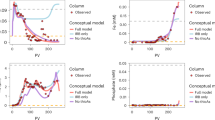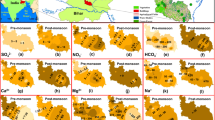Abstract
Tens of millions of people in south and southeast Asia routinely consume ground water that has unsafe arsenic levels1,2. Arsenic is naturally derived from eroded Himalayan sediments, and is believed to enter solution following reductive release from solid phases under anaerobic conditions. However, the processes governing aqueous concentrations and locations of arsenic release to pore water remain unresolved, limiting our ability to predict arsenic concentrations spatially (between wells) and temporally (future concentrations) and to assess the impact of human activities on the arsenic problem3,4,5,6,7,8,9. This uncertainty is partly attributed to a poor understanding of groundwater flow paths altered by extensive irrigation pumping in the Ganges-Brahmaputra delta10, where most research has focused. Here, using hydrologic and (bio)geochemical measurements, we show that on the minimally disturbed Mekong delta of Cambodia, arsenic is released from near-surface, river-derived sediments and transported, on a centennial timescale, through the underlying aquifer back to the river. Owing to similarities in geologic deposition, aquifer source rock and regional hydrologic gradients11,12,13,14,15, our results represent a model for understanding pre-disturbance conditions for other major deltas in Asia. Furthermore, the observation of strong hydrologic influence on arsenic behaviour indicates that release and transport of arsenic are sensitive to continuing and impending anthropogenic disturbances. In particular, groundwater pumping for irrigation, changes in agricultural practices, sediment excavation, levee construction and upstream dam installations will alter the hydraulic regime and/or arsenic source material and, by extension, influence groundwater arsenic concentrations and the future of this health problem.
This is a preview of subscription content, access via your institution
Access options
Subscribe to this journal
Receive 51 print issues and online access
$199.00 per year
only $3.90 per issue
Buy this article
- Purchase on Springer Link
- Instant access to full article PDF
Prices may be subject to local taxes which are calculated during checkout



Similar content being viewed by others
References
Smith, A. H., Lingas, E. O. & Rahman, M. Contamination of drinking-water by arsenic in Bangladesh: A public health emergency. Bull. World Health Organ. 78, 1093–1103 (2000)
Yu, W. H., Harvey, C. M. & Harvey, C. F. Arsenic in groundwater in Bangladesh: A geostatistical and epidemiological framework for evaluating health effects and potential remedies. Wat. Resour. Res. 39, art no. 1146 (2003)
Harvey, C. F. et al. Arsenic mobility and groundwater extraction in Bangladesh. Science 298, 1602–1606 (2002)
Aggrawal, P. K., Basu, A. R. & Julkarni, K. M. Comment on ‘Arsenic mobility and groundwater extraction in Bangladesh’. Science 300, 584b (2003)
van Geen, A., Zheng, Y., Stute, M. & Ahmed, K. M. Comment on ‘Arsenic mobility and groundwater extraction in Bangladesh’. Science 300, 584c (2003)
Harvey, C. F. et al. Response to comments on ‘Arsenic mobility and groundwater extraction in Bangladesh’. Science 300, 584d (2003)
van Geen, A. et al. Spatial variability of arsenic in 6000 tubewells in a 25 km2 area of Bangladesh. Wat. Resour. Res. 39, art no. 1140 (2003)
McArthur, J. M. et al. Natural organic matter in sedimentary basins and its relation to arsenic in anoxic groundwater: The example of West Bengal and its worldwide implications. Appl. Geochem. 19, 1255–1293 (2004)
Polizzotto, M. L., Harvey, C. F., Sutton, S. R. & Fendorf, S. Processes conducive to the release and transport of arsenic into aquifers of Bangladesh. Proc. Natl Acad. Sci. USA 102, 18819–18823 (2005)
Harvey, C. F. et al. Groundwater dynamics and arsenic contamination in Bangladesh. Chem. Geol. 228, 112–136 (2006)
Berg, M. et al. Arsenic contamination of ground and drinking water in Vietnam: A human health threat. Environ. Sci. Technol. 35, 2621–2626 (2001)
Japan International Cooperation Agency. The Study on Groundwater Development in Southern Cambodia (Kokusai Kogyo Co., Tokyo, Japan, 2002)
Stanger, G., Truong, T. V., Ngoc, K. S. L. T. M., Luyen, T. V. & Thanh, T. T. Arsenic in groundwaters of the Lower Mekong. Environ. Geochem. Health 27, 341–357 (2005)
Polya, D. A. et al. Arsenic hazard in shallow Cambodian groundwaters. Mineral. Mag. 69, 807–823 (2005)
Berg, M. et al. Magnitude of arsenic pollution in the Mekong and Red River Deltas – Cambodia and Vietnam. Sci. Tot. Environ. 372, 413–425 (2007)
Nickson, R. et al. Arsenic poisoning of Bangladesh groundwater. Nature 395, 338 (1998)
Smedley, P. L. & Kinnibugh, D. G. A review of the source, behaviour, and distribution of arsenic in natural waters. Appl. Geochem. 17, 517–568 (2002)
Islam, F. S. et al. Role of metal-reducing bacteria in arsenic release from Bengal delta sediments. Nature 430, 68–71 (2004)
Klump, S. et al. Groundwater dynamics and arsenic mobilization in Bangladesh assessed using noble gases and tritium. Environ. Sci. Technol. 40, 243–250 (2006)
Ta, T. K. O. et al. Holocene delta evolution and sediment discharge of the Mekong River, Southern Vietnam. Quat. Sci. Rev. 21, 1807–1819 (2002)
Nguyen, V. L., Ta, T. K. O. & Tateishi, M. Late Holocene depositional environments and coastal evolution of the Mekong River Delta, Southern Vietnam. J. Asian Earth Sci. 18, 427–439 (2000)
Tamura, T. et al. Depositional facies and radiocarbon ages of a drill core from the Mekong River lowland near Phnom Penh, Cambodia: Evidence for tidal sedimentation at the time of Holocene maximum flooding. J. Asian Earth Sci. 29, 585–592 (2007)
Swartz, C. H. et al. Mobility of arsenic in a Bangladesh aquifer: Inferences from geochemical profiles, leaching data, and mineralogical characterization. Geochim. Cosmochim. Acta 68, 4539–4557 (2004)
Stute, M. et al. Hydrological control of As concentrations in Bangladesh groundwater. Wat. Resour. Res. (in the press)
Postma, D. K. et al. Arsenic in groundwater of the Red River floodplain, Vietnam: Controlling geochemical processes and reactive transport modeling. Geochim. Cosmochim. Acta 71, 5054–5071 (2007)
Rowland, H. A. L. et al. The control of organic matter on microbially mediated iron reduction and arsenic release in shallow alluvial aquifers, Cambodia. Geobiology 5, 281–292 (2007)
Lear, G., Song, B., Gault, A. G., Polya, D. A. & Lloyd, J. R. Molecular analysis of arsenate-reducing bacteria within Cambodian sediments following amendment with acetate. Appl. Environ. Microbiol. 73, 1041–1048 (2007)
Pederick, R. L., Gault, A. G., Charnock, J. M., Polya, D. A. & Lloyd, J. R. Probing the biogeochemistry of arsenic: Response of two contrasting aquifer sediments from Cambodia to stimulation by arsenate and ferric iron. J. Environ. Sci. Health A 42, 1763–1774 (2007)
Landsat map ID 039-880, 11 July 2001 (Global Land Cover Facility, University of Maryland); downloaded for Path 126, Row 052 using the Earth Science Data Interface 〈http://glcfapp.umiacs.umd.edu:8080/esdi/index.jsp〉.
Acknowledgements
This work was supported by Stanford University, US NSF and US EPA STAR. We thank K. Ouch, K. Phan, co-workers at Resource Development International, G. Li, M. Meyer, M. Busbee and A. Aziz for field and laboratory assistance; S. Ganguly for modelling assistance; and A. Boucher for help with spatial analyses.
Author Contributions All authors contributed to the intellectual design, execution, interpretation and analyses presented in this study. M.L.P. assessed groundwater hydrology and geochemistry; B.D.K. analysed near-surface biogeochemistry; S.G.B. established the hydrologic framework (field layout and data collection) and conducted the modelling; M.S. facilitated the field work and provided the scientific history of the area; S.F. provided the project impetus, biogeochemical deduction, and, with S.G.B. and M.L.P., site selection. M.L.P., S.G.B. and S.F. wrote the manuscript with input from B.D.K.
Author information
Authors and Affiliations
Corresponding author
Supplementary information
Supplementary information
This file contains Supplementary Methods, field area description, groundwater flow calculations, numerical modeling results, dissolved and solid-phase chemical data, and mass balance calculations from our study of the Upper Mekong Delta, Cambodia. The material is organized as 7 sections with an appendix and includes Supplementary Tables 1-4 and Supplementary Figures 1-9. Additional methods are described in Section 1 of the Supplementary Information. Section 2 provides information about the geologic history, stratigraphy (Supplementary Figure 1), aqueous chemistry (Supplementary Table 1), and land use practices within our field area. Groundwater flux calculations are presented in Section 3, including hydraulic heads throughout the field area (Supplementary Figures 2 and 3), hydraulic conductivity results (Supplementary Tables 2), and flow distances (Supplementary Table 2). The results of groundwater flow modeling (Supplementary Table 4 and Supplementary Figures 4 and 5) are shown in Section 4. Section 5 discusses the spatial distribution (Supplementary Figures 6 and 7) and temporal variations (Supplementary Figure 8) of dissolved arsenic concentrations and solid-phase redox profiles of arsenic (Supplementary Figure 9). Section 6 outlines arsenic input and output calculations. Supplementary Information references are given in Section 7, and all groundwater arsenic measurements are presented in the Supplementary Information Appendix. (PDF 3001 kb)
Rights and permissions
About this article
Cite this article
Polizzotto, M., Kocar, B., Benner, S. et al. Near-surface wetland sediments as a source of arsenic release to ground water in Asia. Nature 454, 505–508 (2008). https://doi.org/10.1038/nature07093
Received:
Accepted:
Published:
Issue Date:
DOI: https://doi.org/10.1038/nature07093
This article is cited by
-
Environmental Isotopes and Cl/Br Ratios Evidences for Delineating Arsenic Mobilization in Aquifer System of the Jianghan Plain, Central China
Journal of Earth Science (2023)
-
Occurrence, speciation, and controls on arsenic mobilization in the alluvial aquifer system of the Ghaghara basin, India
Environmental Geochemistry and Health (2023)
-
Monthly variations of groundwater arsenic risk under future climate scenarios in 2081–2100
Environmental Science and Pollution Research (2023)
-
Identification of microbiogeochemical factors responsible for arsenic release and mobilization, and isolation of heavy metal hyper-tolerant bacterium from irrigation well water: a case study in Rural Bengal
Environment, Development and Sustainability (2023)
-
Appraisal of groundwater arsenic on opposite banks of River Ganges, West Bengal, India, and quantification of cancer risk using Monte Carlo simulations
Environmental Science and Pollution Research (2022)
Comments
By submitting a comment you agree to abide by our Terms and Community Guidelines. If you find something abusive or that does not comply with our terms or guidelines please flag it as inappropriate.



